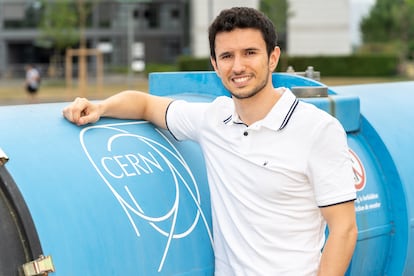Research about the universe leads to new cancer detection tools
Two award-winning computer scientists have found potentially life-saving applications for their work
Research into the origin and behavior of the universe is often questioned for its lack of practical application in everyday life. If the ability to learn more about our world and life on Earth doesn’t convince you of the value of this research, perhaps the recent honors bestowed on two young Spanish computer scientists will. The award-winning artificial intelligence research conducted by Saúl Alonso Monsalve and Pablo Morales Álvarez to identify neutrinos and measure the effects of gravitational waves – two unique aspects of our universe – enabled them to develop tools that can help diagnose cancer in just a few milliseconds.
Neutrinos are the second most abundant particle in the universe after photons (particles of light). Billions of neutrinos are able to constantly pass through matter like our bodies because they lack an electric charge and only interact with the weak nuclear force (one of the four known fundamental interactions, with the others being electromagnetism, the strong interaction, and gravitation). Neutrinos also have mass, although it is not known how much or how it originates, and they travel in a straight line, which makes them unique messengers of information about the universe’s origins. But these attributes make them very difficult to detect, to the extent that they are also called “ghost particles.”
Neutrinos come in three types, or flavors – electron, muon and tau. Because they oscillate, says Alonso Monsalve, “we can determine if it has changed by measuring the flavor of a neutrino after it has been generated.” Matter particles interact with antimatter, which is called a charge parity (CP) violation. Thus, neutrinos and antineutrinos oscillate differently. “Discovering CP violation in the neutrino sector could ultimately explain the difference between matter and antimatter in the universe, and provide a great deal of information about its origin,” said Monsalve.
To unravel the mysteries of neutrinos, Monsalve participated in the Deep Underground Neutrino Experiment (DUNE), which uses an accelerator in the United States equipped with ghost particle beam detectors. Monsalves developed an algorithm that identifies the flavor of the neutrino after it makes a long journey through the accelerator. He says it’s analogous to a facial recognition system that can use a passport photo to determine whether the traveler who left one country and arrived in another is the same person, and how the journey affected the traveler.
“My work,” said Monsalve, “involves collecting the images from the detectors and applying artificial intelligence algorithms to understand what’s happening. Even experts can’t determine the neutrino flavor with 100% confidence by observation alone. The artificial intelligence algorithms identify the neutrino and create a 3D reconstruction of the particles from the 2D images captured by the detectors. They also filter out noise, because these 2D images don’t exactly represent what happened.”

Pablo Morales Álvarez’s award-winning work focused on the universe’s gravitational waves. These are ripples caused by very violent events, such as a merger of two black holes or a supernova, which travel at the speed of light and alter space-time. This effect was predicted by Albert Einstein over 100 years ago, but could not be demonstrated until September 2015 when GW150914 – the first direct observation of gravitational waves – was made. These ripples, like the ones observed on the skins of percussion instruments, physically distort everything in their path, but the traces that eventually reach Earth are virtually undetectable.
Morales collaborated with the Laser Interferometer Gravitational-Wave Observatory (LIGO) in the United States in an experiment to identify minuscule (millionths of a millimeter) alterations in a metallic structure caused by gravitational waves. “It’s like gaining a sixth sense,” said Morales, who explained that gravitational waves are not like sound or electromagnetic waves, which don’t propagate in a vacuum. “They have a completely different nature, hence our interest in them.”
“What we want to do now,” said Morales, “is automate and accelerate the process of detecting gravitational waves. Because they leave an imprint, my job has been to create an algorithm that automates the process of discriminating between what is a gravitational wave and what is not. An expert could do this manually, but the volume of data is so large that it’s impossible for a physicist to read all that information to identify a wave.” Since the algorithm does not learn on its own and is fed by information from a group of trained volunteers, Morales has added functionality to identify the source of information and its degree of reliability based on other observations.
While Monsalve and Morales are both working to understand more about the universe, their research also has important applications closer to home. Monsalve has used his expertise in neutrino identification to develop an algorithm capable of pinpointing liver cancer within milliseconds using radiology images. His system can convert 2D images into 3D reconstructions, which facilitates a much more accurate and complete analysis. His model uses input from experts around the world who analyzed a data set of 300 radiology images, to teach an artificial intelligence system to identify and locate tumors. “This doesn’t replace an expert human diagnosis, but it does provide a very quick tool to help and guide the expert.”
Morales has also applied his experience in gravitational wave detection to identify tumors from microscopic images of tissue biopsies. “It’s a diagnostic aid that alerts the pathologist to the presence and location of patterns congruent with cancer.”
Sign up for our weekly newsletter to get more English-language news coverage from EL PAÍS USA Edition
Tu suscripción se está usando en otro dispositivo
¿Quieres añadir otro usuario a tu suscripción?
Si continúas leyendo en este dispositivo, no se podrá leer en el otro.
FlechaTu suscripción se está usando en otro dispositivo y solo puedes acceder a EL PAÍS desde un dispositivo a la vez.
Si quieres compartir tu cuenta, cambia tu suscripción a la modalidad Premium, así podrás añadir otro usuario. Cada uno accederá con su propia cuenta de email, lo que os permitirá personalizar vuestra experiencia en EL PAÍS.
¿Tienes una suscripción de empresa? Accede aquí para contratar más cuentas.
En el caso de no saber quién está usando tu cuenta, te recomendamos cambiar tu contraseña aquí.
Si decides continuar compartiendo tu cuenta, este mensaje se mostrará en tu dispositivo y en el de la otra persona que está usando tu cuenta de forma indefinida, afectando a tu experiencia de lectura. Puedes consultar aquí los términos y condiciones de la suscripción digital.
More information
Últimas noticias
Most viewed
- Reinhard Genzel, Nobel laureate in physics: ‘One-minute videos will never give you the truth’
- Pablo Escobar’s hippos: A serious environmental problem, 40 years on
- Charles Dubouloz, mountaineering star, retires at 36 with a farewell tour inspired by Walter Bonatti
- Why we lost the habit of sleeping in two segments and how that changed our sense of time
- The fall of a prolific science journal exposes the billion-dollar profits of scientific publishing











































